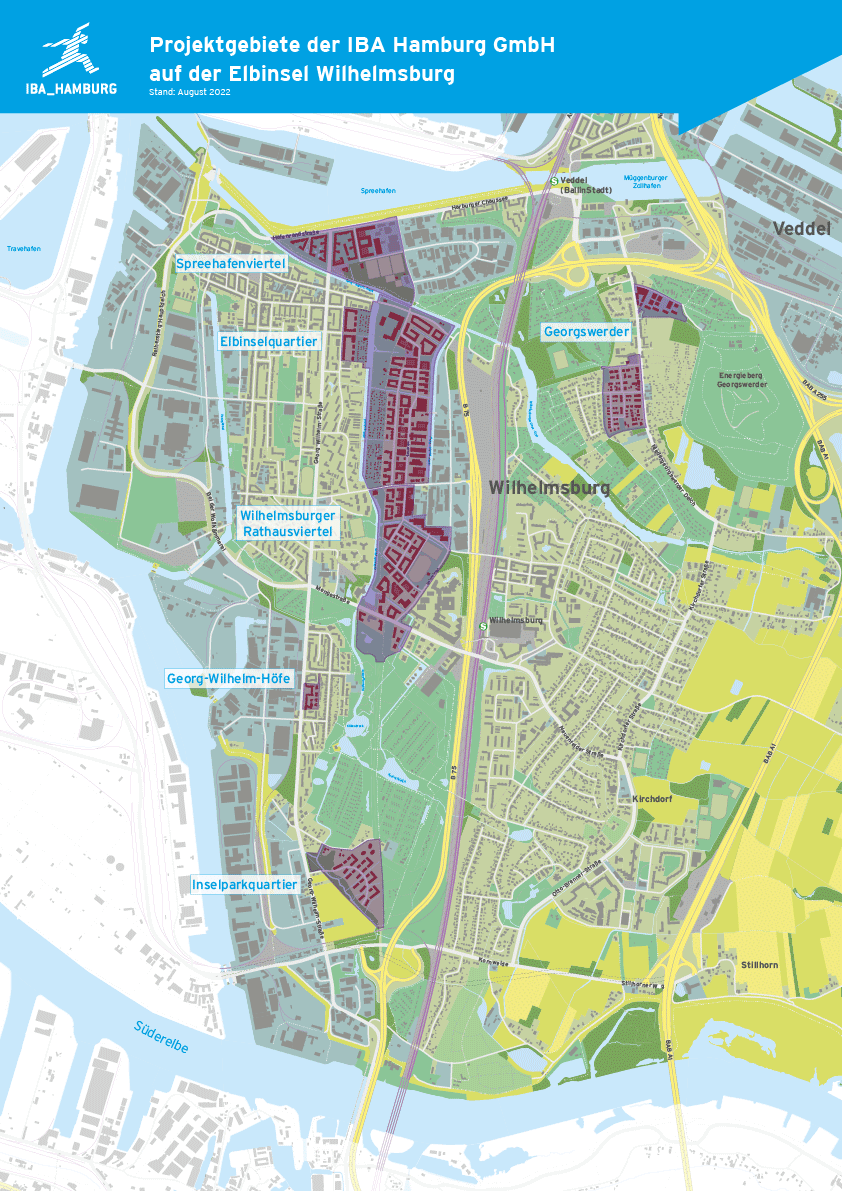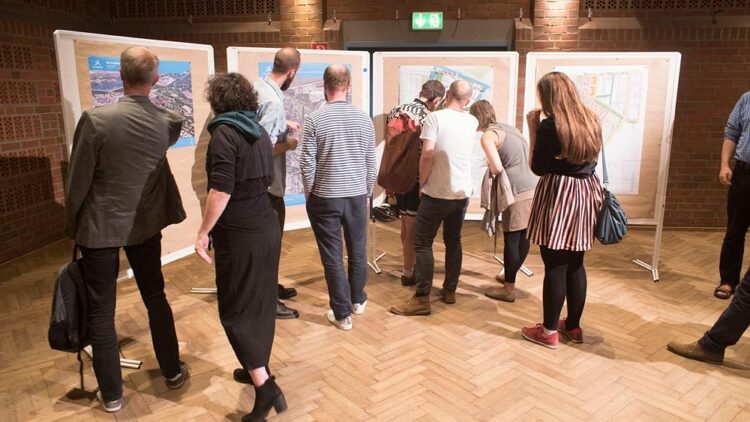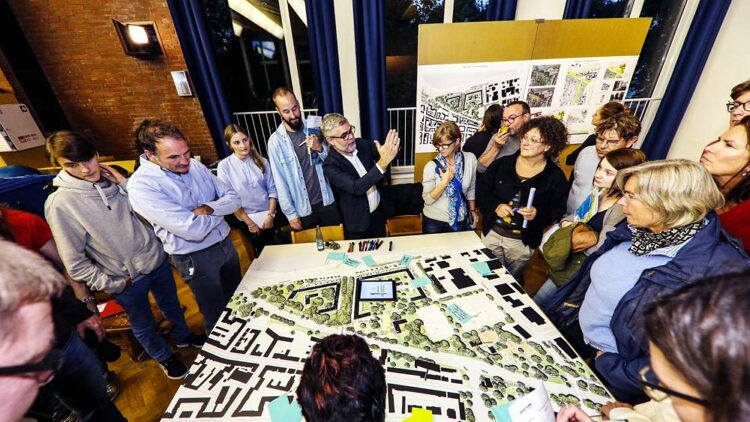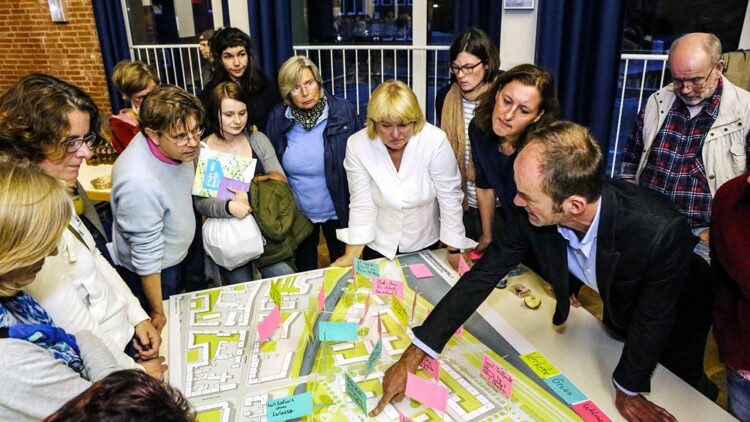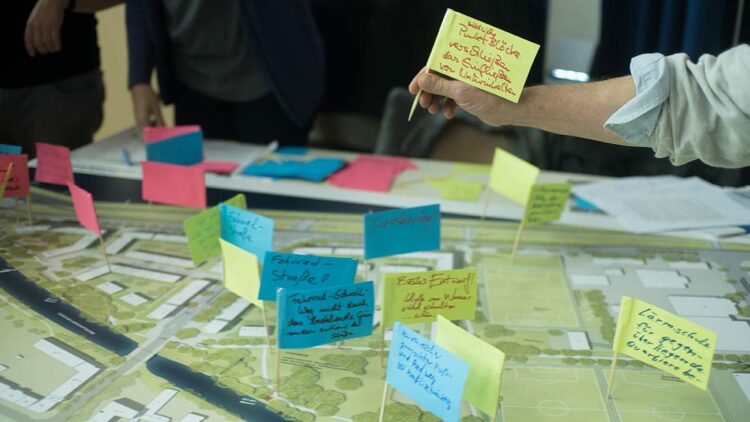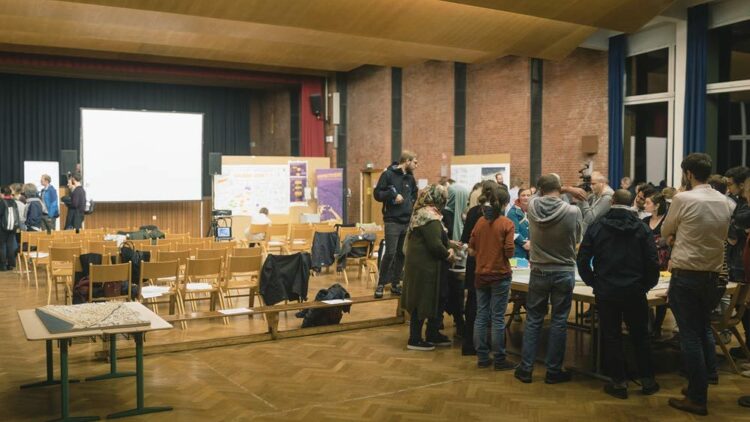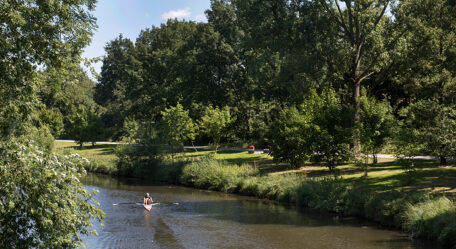Spreehafenviertel (Spreehafen District): New urban neighbourhoods
Total area:
20 ha
Housing units:
approx. 1.100
Leafy and open space:
approx. 3 ha
Industrial real estate:
50,000 m²
On the roughly 20-hectare area between the Gründerzeit-era Reiherstiegviertel, the Ernst-August-Kanal and the Spreehafen, a lively district has been planned – the Spreehafenviertel (Spreehafen District). It is in the north of Wilhelmsburg and borders the south bank of the Spreehafen, a popular local recreation area (map). A varied range of townhouses and apartment buildings is to be built here, as well as new workplaces, open areas and leafy spaces. A central, public square by the water and connections to existing neighbourhoods, in particular the Reiherstiegviertel and Elbinselquartier (Elbe Island District) are essential characteristics of the new district. The Spreehafenviertel (Spreehafen District) will also derive a lot of character from the retained leafy spaces by the Ernst-August-Kanal. Here, new cycle paths and a large children’s playground will be created.
The Spreehafenviertel (Spreehafen District) project area is characterised today by large areas of trees, commercial usages and a sports complex which is to be relocated and enlarged in the course of the project.
The new district will be the key- and cornerstone of the urban landscape of Wilhelmsburg. In the north, an important connection to the water’s edge at the Spreehafen will be created. In the south, the Spreehafenviertel (Spreehafen District) joins onto the Reiherstiegviertel (Reiherstieg District) and in the south-east to the Elbinselquartier (Elbe Island District). With the green corridor along the Ernst-August-Kanal, the Wilhelmsburg Dove Elbe landscape axis will be continued and further developed into a usable green space. Two new bridges over the Ernst-August-Kanal are planned, in order to extend and improve the cycle and footpath network.
The urban structure follows the pattern of the Reiherstiegviertel (Reiherstieg District) with urban blocks and structures based around spacious inner and back courtyards, which become places of neighbourliness and encounter. In the Spreehafenviertel (Spreehafen District), a wide range is on offer: residential and office blocks, apartment buildings and cooperatives, townhouses and a free-standing building on the main square. The aim is to implement the Hamburg housing policy of the “three-way split” and to create housing for all of Hamburgs citizens. From classic multi-bedroom housing units for families to accommodation for senior citizens, students, people with low income, people with disabilities and other target groups. IBA Hamburg will also react to future living environments, with flexible floor plans or combinations of living and work spaces. There will also be a large proportion of plots on offer for building cooperatives
In the Spreehafenviertel (Spreehafen District), the existing stock of trees is of special importance. During the urban/open space planning workshop process here, planners and citizens looked for solutions to retain as many of the important trees as possible. The public leafy spaces are to be developed using a natural open space concept, based on ecological design principles and avoiding large-scale intervention. Interior paths have been adjusted to retain trees. Natural recreation areas and occasional gangways, seating steps and stairways on the banks of the canal invite people to stay and enjoy the space. Three kindergartens, a large playground and several smaller ones are available to children and families.
A sports complex with a total of three football fields and five tennis courts, with accompanying clubhouses, is available to clubs and the district school.
The Spreehafenviertel (Spreehafen District) is connected to the public transport system via bus connections and the Veddel S-Bahn station. In the coalition agreement of 2020, the new senate is committed to implement the construction measures and further development of the U4 in the direction of Grasbrook and Veddel. In connection with the development of Kleiner Grasbrook, the U4 is to be planned up to there. In addition, the foundations for a development beyond Grasbrook are to be laid. Routes are to be examined and, if possible, areas are to be kept free. According to the coalition agreement, this applies in particular to the northern part of Wilhelmsburg.
A flexible and transparent process was used to work step by step towards finding ideal solutions for the new district and connections to existing neighbourhoods. Planning teams, citizens and specialists worked together in close cooperation on a concept for the project area. The goal was to develop an urban district, oriented to the needs of the people who would live there in the future, with a diverse mixture of residential, commercial and leisure space. Throughout the planning process, various workshops, campaigns in the district and surveys were carried out with online and on-site participation.
From the start of June 2017 to mid-December 2017, the IBA Hamburg GmbH carried out the urban/open space planning workshop process “New urban neighbourhoods” for the Spreehafenviertel, in collaboration with the Ministry for Urban Development and Housing and the District office Hamburg-Mitte. Citizen participation, which had begun even before the creation of the task paper, was transferred to the project “Perspectives! Planning together for the Elbe Islands” of the Wilhelmsburg Community Centre Foundation and its cooperating partners, the Advisory Council for Urban Development, Wilhelmsburg, and the vhw Federal Association for Housing and Urban Development e. V.
The following three planning teams took part in the workshop process:
- BIWERMAU Architekten BDA, Hamburg with WES LandschaftsArchitektur, Hamburg
- COBE, Berlin with Felixx, Rotterdam
- Renner Hainke Wirth Zirn Architekten, Hamburg with G2 Landschaft, Hamburg
On 19 December 2017, the panel unanimously decided on the design by BIWERMAU Architekten BDA with WES LandschaftsArchitektur. In a public final presentation, the participating citizens favoured a different design. For this reason, an additional public workshop to present the winning design and discuss possibilities for reworking it was held in February 2018.
A review of the workshop process
What happens next?
The IBA Hamburg provides yearly information in a public project dialogue on the current state of planning and answers questions from citizens.
Currently, building permissions are being obtained for the Spreehafenviertel (Spreehafen District) under the leadership of the District office Hamburg-Mitte. After formal approval, interested investors, housing associations and building cooperatives will be able to find plots on offer on this page. No plots for single-family homes are intended. IBA Hamburg is not responsible for rental and sale of housing units.
At a glance:
District development in Wilhelmsburg
The three project areas of the Spreehafenviertel (Spreehafen District), Elbinselquartier (Elbe Island District) and Wilhelmsburger Rathausviertel (Wilhelmsburg Town Hall District) run from the north of the island to the Inselpark. The potential for residential construction here could provide around 4,800 new housing units. A particular feature is the green axis to be created by the developments.
With Georgswerder in the east of the island, a further 190 housing units and commercial spaces will be added.
Another approx. 800 housing units may be built in the Georg-Wilhelm-Höfe (Georg-Wilhelm Courtyards) and Inselparkquartier (Inselpark District). Here, the legal land use planning procedures are currently being prepared or are up and running.
